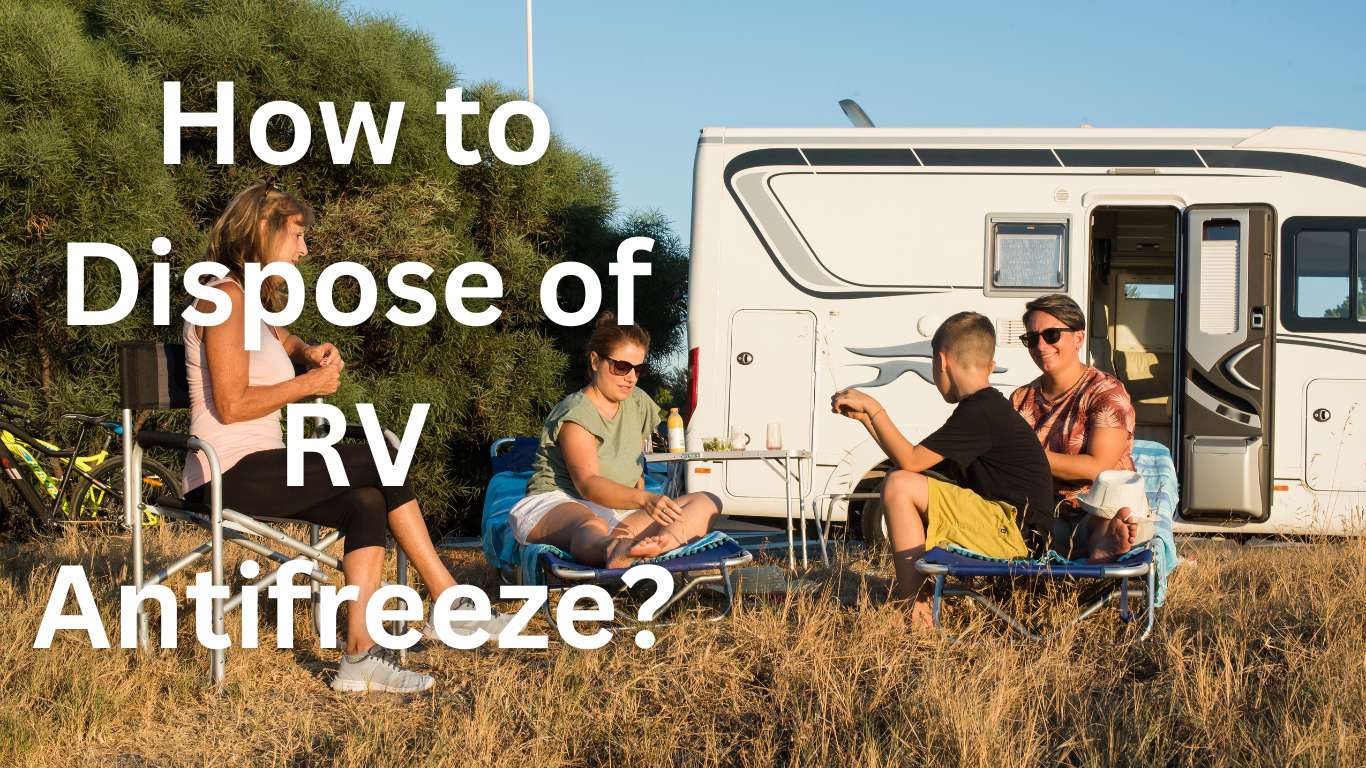RV antifreeze is essential for protecting your recreational vehicle during freezing temperatures, but improper disposal can harm the environment. Learning how to dispose of RV antifreeze correctly ensures safety and compliance with local regulations.
Is RV Antifreeze Safe to Dispose of?
Not all RV antifreeze is the same. Some types are biodegradable and non-toxic, while others contain harmful chemicals like ethylene glycol. Here’s what you need to know:
Types of RV Antifreeze
- Propylene Glycol – Non-toxic and safe for septic systems.
- Ethylene Glycol – Toxic and requires careful handling.
Always check the product label to determine its composition before disposal.
Factors That Force You to Dispose of RV Antifreeze
Disposing of RV antifreeze properly is a responsibility every RV owner must prioritize. Several factors make it necessary to dispose of antifreeze, ensuring your RV remains in top condition and the environment stays protected.
Why Dispose of RV Antifreeze?
RV antifreeze plays a crucial role in safeguarding your recreational vehicle during winter. However, various circumstances require its safe disposal.
1. End of Winterization Season
At the start of the camping season, you’ll need to remove antifreeze from your RV’s plumbing system. This ensures water flows safely and tastes fresh.
2. Switching Between Antifreeze Types
If you decide to switch from one type of antifreeze (e.g., ethylene glycol to propylene glycol), it’s essential to drain and dispose of the old antifreeze first. Mixing different types can reduce effectiveness and lead to plumbing damage.
3. Expired or Contaminated Antifreeze
Antifreeze doesn’t last forever. Over time, it can degrade or become contaminated with dirt, oil, or debris, reducing its ability to protect your RV. Disposing of expired antifreeze prevents damage to your vehicle’s plumbing and engine.
4. Environmental Protection
Improperly stored antifreeze can leak, harming wildlife, plants, and waterways. Disposing of it responsibly ensures compliance with environmental regulations and safeguards ecosystems.
5. Unnecessary Use
If you’ve mistakenly overfilled your RV’s plumbing system with antifreeze, the excess must be drained and disposed of properly to avoid clogging or performance issues.
Methods to Dispose of RV Antifreeze
Disposing of RV antifreeze correctly is crucial for protecting the environment and complying with regulations. Whether it’s biodegradable or toxic, here are the best methods to safely handle RV antifreeze disposal.
Why Proper Disposal Matters
RV antifreeze contains chemicals that can harm the environment if not disposed of properly. Following these methods ensures safety and compliance while minimizing environmental impact.
1. Determine the Type of Antifreeze
Before disposal, identify whether the antifreeze is:
- Non-Toxic (Propylene Glycol): Biodegradable and safe for septic systems.
- Toxic (Ethylene Glycol): Harmful and must be treated as hazardous waste.
Check the product label to confirm its composition.
2. Use a Hazardous Waste Facility
For toxic antifreeze containing ethylene glycol:
- Collect it in a sealable container.
- Take it to a local hazardous waste facility or recycling center.
- Never pour it into drains, septic systems, or on the ground.
3. Dispose of Non-Toxic Antifreeze Safely
For antifreeze labeled as biodegradable or non-toxic:
- Confirm local regulations with waste management authorities.
- If approved, pour it into a sanitary sewer system. Avoid storm drains.
- Do not mix it with other household waste.
4. Recycle Antifreeze When Possible
Recycling centers often accept used antifreeze, whether toxic or non-toxic. Recycling reduces waste and ensures safe reuse of materials.
5. Consult RV Service Centers
Many RV repair shops and service centers offer antifreeze disposal services. They ensure proper handling and disposal based on the type of antifreeze.
6. Avoid Harmful Practices
- Do not pour antifreeze outdoors: It can contaminate soil and water.
- Keep it away from children and pets: Even non-toxic antifreeze can be harmful if ingested.
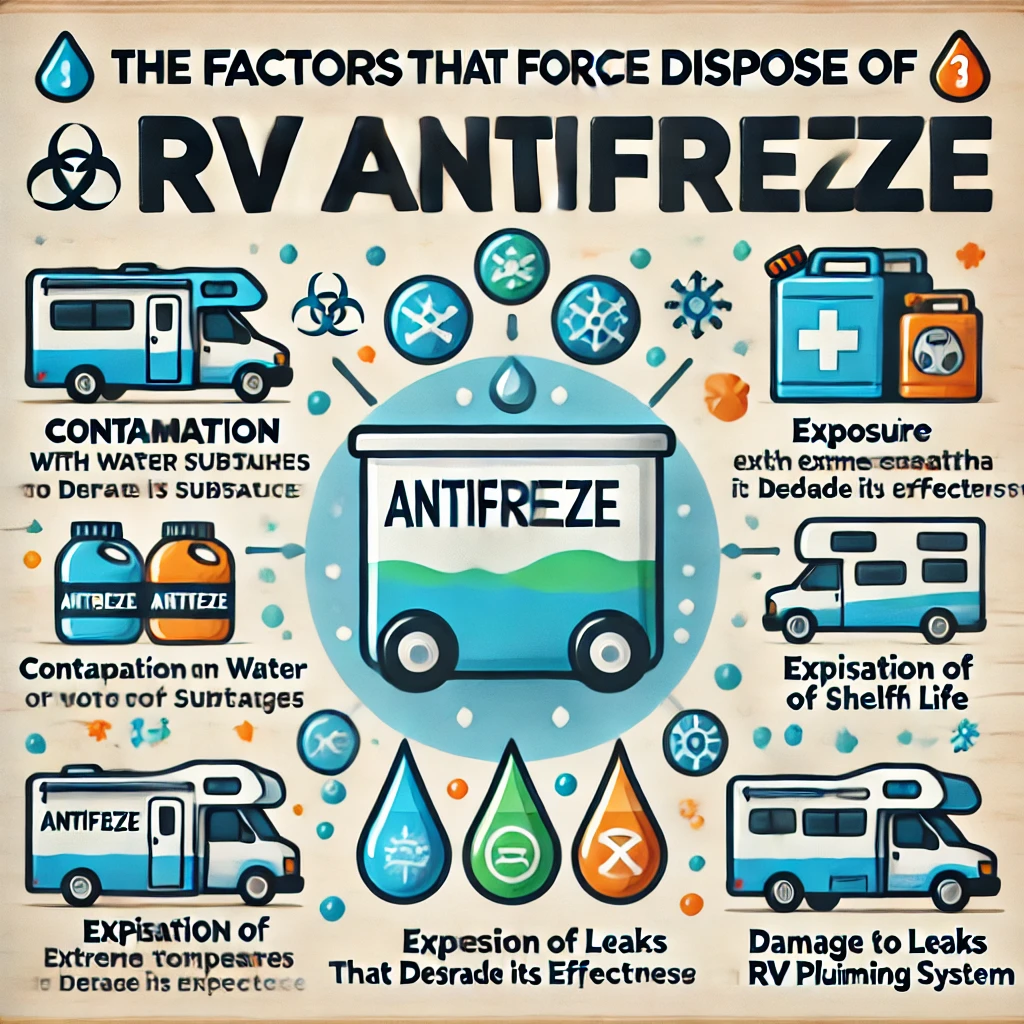
Essential Tools to Dispose of RV Antifreeze
Properly disposing of RV antifreeze requires the right tools to ensure safety, compliance, and ease. Using these essential tools helps streamline the process while protecting the environment.
Why Use Proper Tools for Antifreeze Disposal?
Having the right tools prevents spills, safeguards the environment, and ensures the safe handling of both toxic and non-toxic RV antifreeze.
1. Drainage Hose
A high-quality drainage hose is essential for efficiently removing antifreeze from your RV’s plumbing system without making a mess.
2. Sealable Containers
Use durable, sealable containers to store used antifreeze temporarily. These containers prevent leaks and make transportation to disposal facilities safe.
3. Funnel
A funnel helps you pour antifreeze into containers or disposal systems without spilling. This tool is especially useful when handling large quantities.
4. Protective Gear
- Gloves: Protect your skin from harmful chemicals.
- Goggles: Shield your eyes from potential splashes.
- Mask: Use a mask in poorly ventilated areas to avoid inhaling fumes.
5. Antifreeze Testing Kit
An antifreeze testing kit helps you determine whether the antifreeze is still effective or needs disposal. It’s a useful tool to prevent unnecessary waste.
6. Wrench or Pliers
These tools help loosen and tighten connections when draining antifreeze from tanks and plumbing lines.
7. Cleaning Supplies
- Rags or Paper Towels: Clean up any spills immediately.
- Soap and Water: Wash contaminated surfaces or tools after handling antifreeze.
8. Labels for Containers
Label used antifreeze containers clearly to indicate whether they contain toxic or non-toxic substances. This ensures proper handling at disposal or recycling centers.
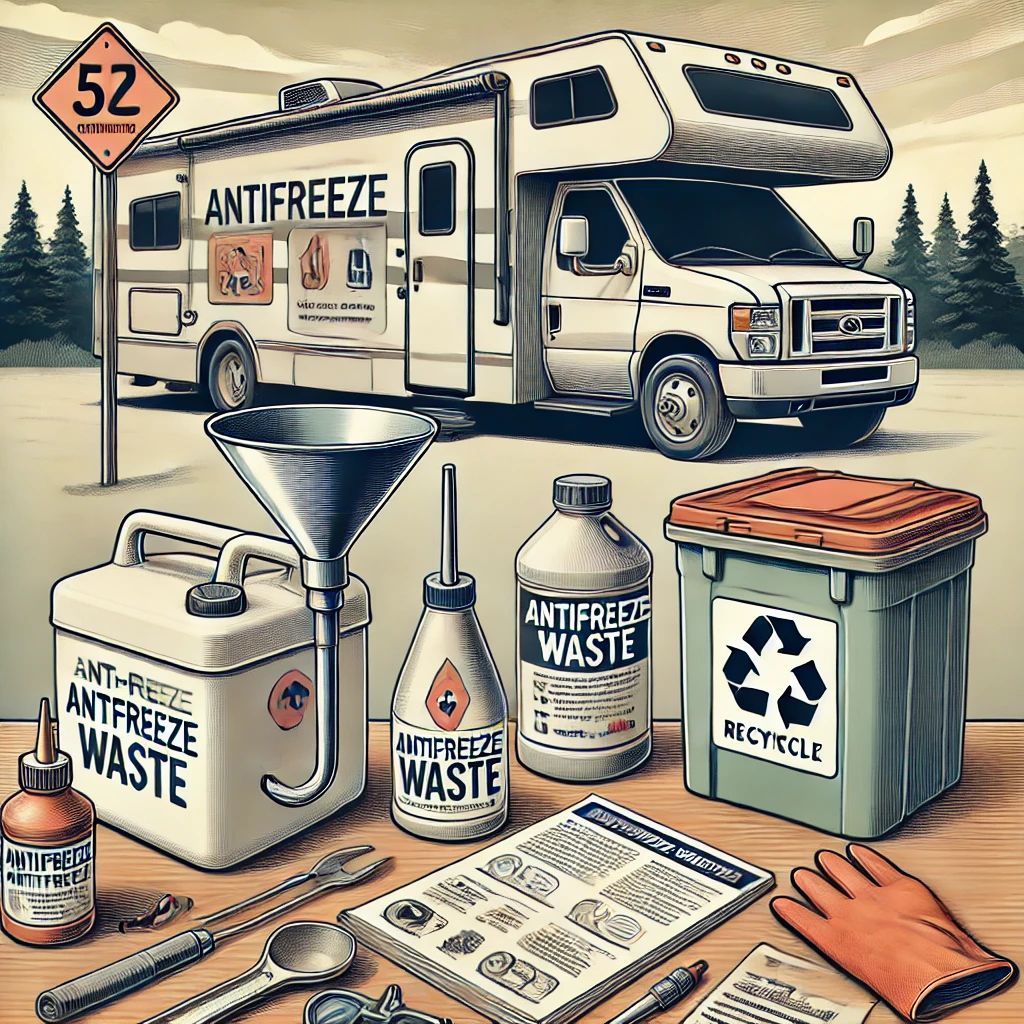
Steps to Dispose of RV Antifreeze
Proper disposal of RV antifreeze is crucial for protecting the environment and maintaining your RV’s plumbing system. Follow these steps to ensure safe, responsible, and legal disposal.
Why Proper Disposal of RV Antifreeze Matters
RV antifreeze, especially toxic varieties, can harm the environment if mishandled. By following these steps, you can prevent contamination and comply with local regulations.
Determine the Type of Antifreeze
- Check the label to identify whether the antifreeze is non-toxic (propylene glycol) or toxic (ethylene glycol).
- Non-toxic antifreeze is generally safe for septic systems, while toxic types require hazardous waste handling.
Drain the Antifreeze Safely
- Connect a drainage hose to your RV’s plumbing system.
- Use a clean container to collect the antifreeze as it drains. Avoid spilling it on the ground or mixing it with other substances.
Store Used Antifreeze in a Sealable Container
- Transfer the collected antifreeze into a labeled, sealable container.
- Clearly mark whether the antifreeze is toxic or non-toxic to ensure proper handling later.
Consult Local Regulations
- Contact your local waste management authority to understand disposal requirements.
- Regulations may vary based on the antifreeze type and local environmental laws.
Dispose of Antifreeze Appropriately
For Non-Toxic Antifreeze:
- If permitted, pour it into a sanitary sewer system (not storm drains).
- Confirm with local authorities before proceeding.
For Toxic Antifreeze:
- Take it to a hazardous waste facility or recycling center.
- Many automotive shops also accept used toxic antifreeze for safe disposal.
Step 6: Recycle When Possible
- Recycling centers often accept both toxic and non-toxic antifreeze.
- This environmentally friendly option ensures proper treatment and reuse.
Step 7: Clean Up Thoroughly
- Wash all tools and containers used during the disposal process.
- Clean up any spills immediately to prevent harm to the environment or wildlife.
Do You Need a Professional to Dispose of RV Antifreeze, or Can You Do It Yourself?
Disposing of RV antifreeze is an important responsibility for any RV owner. While some situations may require professional assistance, many can handle the process themselves with the right knowledge and tools. Let’s explore when you can DIY and when to call a professional.
Can You Dispose of RV Antifreeze Yourself?
In most cases, you can dispose of RV antifreeze on your own if you follow proper procedures and local regulations. Here’s what to consider:
When DIY Disposal is Appropriate
1. Using Non-Toxic RV Antifreeze
- Non-toxic antifreeze (propylene glycol) is biodegradable and easier to dispose of responsibly.
- You can often pour it into a sanitary sewer system with permission from local authorities.
2. Familiarity with Local Regulations
- If you understand your area’s waste disposal rules, handling antifreeze yourself is straightforward.
3. Proper Tools and Safety Measures
- With tools like a drainage hose, sealable containers, and protective gear, DIY disposal is safe and efficient.
When to Call a Professional
1. Disposing of Toxic Antifreeze
- Toxic antifreeze (ethylene glycol) requires careful handling. A professional ensures it is disposed of in compliance with hazardous waste guidelines.
2. Large Quantities of Antifreeze
- If your RV uses a large amount of antifreeze, professionals have the equipment to handle and transport it safely.
3. Uncertainty About Local Regulations
- If you’re unsure about disposal rules or lack access to a hazardous waste facility, a professional can manage the process for you.
4. Avoiding Environmental Risks
- Professionals minimize risks of spills, leaks, or improper disposal that could harm the environment.
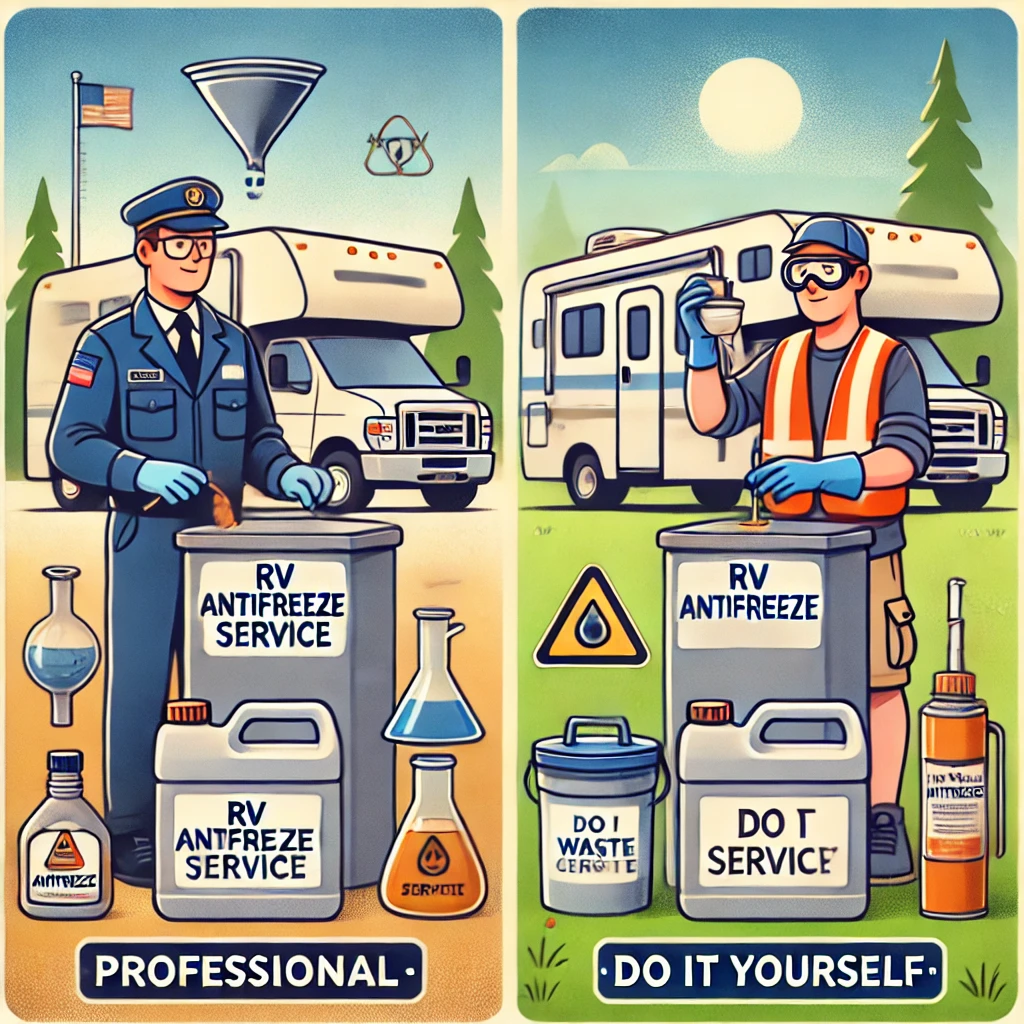
Common Mistakes When Disposing of RV Antifreeze and Their Solutions
Disposing of RV antifreeze improperly can harm the environment, violate regulations, and damage your RV’s plumbing. Here are the most common mistakes RV owners make during disposal and practical solutions to avoid them.
Why Proper Disposal of RV Antifreeze Matters
RV antifreeze contains chemicals that can pollute water and soil if mishandled. Following the right steps not only protects the environment but also ensures compliance with waste disposal laws.
Mistake 1: Pouring Antifreeze on the Ground
Problem:
Some RV owners think it’s harmless to pour antifreeze into soil or grass. However, even non-toxic antifreeze can harm plants, animals, and groundwater.
Solution:
- Collect antifreeze in a sealable container.
- Take it to a hazardous waste facility or follow local guidelines for disposal.
Mistake 2: Disposing of Antifreeze in Storm Drains
Problem:
Storm drains lead directly to rivers and lakes, causing environmental pollution. Toxic antifreeze can harm aquatic life and ecosystems.
Solution:
- Only dispose of antifreeze in a sanitary sewer system with permission from local authorities.
- Never pour it into outdoor drains.
Mistake 3: Mixing Antifreeze with Other Substances
Problem:
Combining antifreeze with oil, gasoline, or other chemicals creates hazardous waste that is difficult to dispose of safely.
Solution:
- Use separate containers for used antifreeze.
- Label containers clearly to prevent mixing and ensure proper handling.
Mistake 4: Using Incorrect Disposal Methods for Toxic Antifreeze
Problem:
Toxic antifreeze, like ethylene glycol, is often mishandled because its hazardous nature is underestimated.
Solution:
- Confirm the type of antifreeze before disposal.
- Take toxic antifreeze to a certified hazardous waste facility.
Mistake 5: Ignoring Local Disposal Regulations
Problem:
Disposing of antifreeze without checking local rules can lead to fines and environmental damage.
Solution:
- Contact your local waste management authority for guidance.
- Follow all regulations to ensure legal and safe disposal.
Mistake 6: Not Recycling Antifreeze
Problem:
Many RV owners throw away antifreeze that could have been recycled, wasting resources and contributing to unnecessary waste.
Solution:
- Locate a recycling center or automotive service shop that accepts used antifreeze.
- Recycle both toxic and non-toxic antifreeze whenever possible.
Mistake 7: Skipping Protective Measures
Problem:
Handling antifreeze without gloves, goggles, or proper tools increases the risk of spills and exposure to harmful chemicals.
Solution:
- Wear protective gear like gloves and goggles.
- Use a funnel to pour antifreeze into containers without spilling.
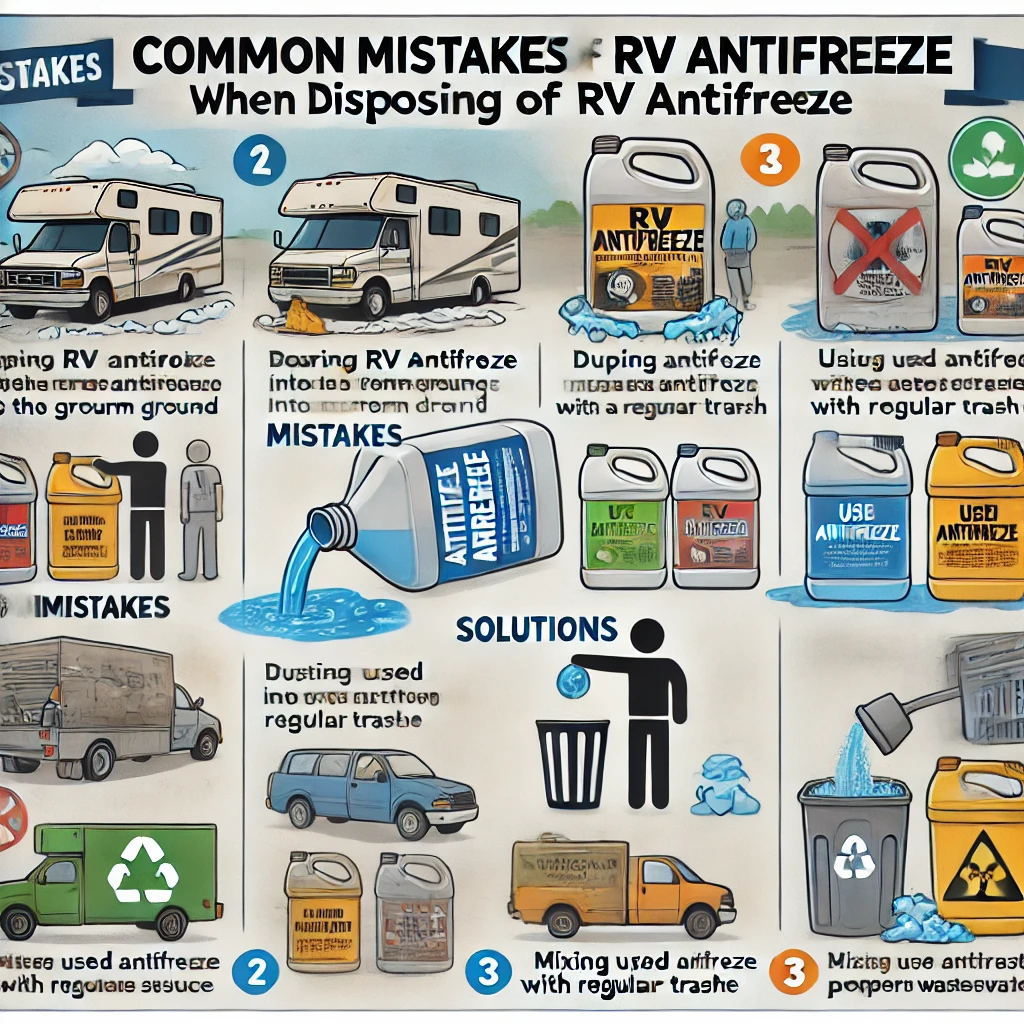
Safety Precautions to Dispose of RV Antifreeze
Disposing of RV antifreeze responsibly is essential for protecting the environment, your health, and your RV’s systems. Following the right safety precautions minimizes risks and ensures compliance with regulations.
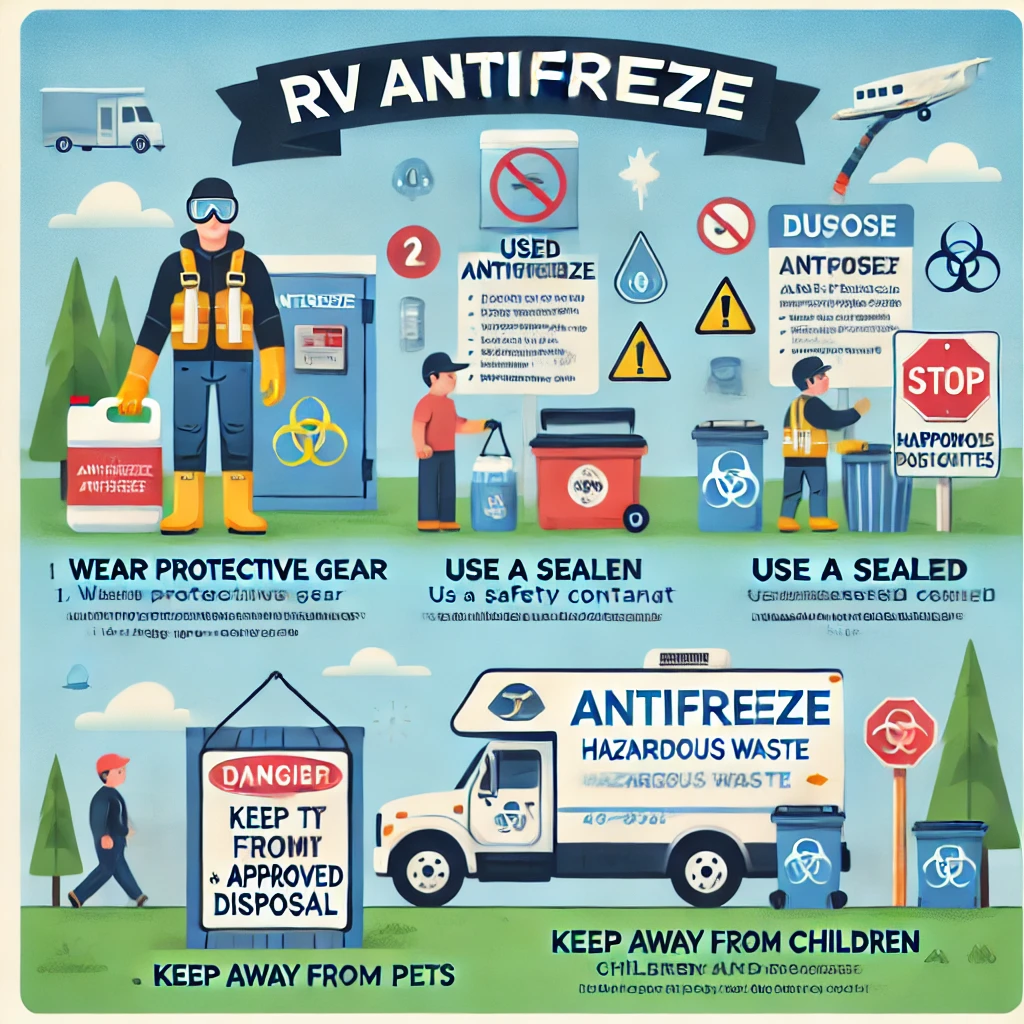
Why Safety Matters When Disposing of RV Antifreeze
RV antifreeze contains chemicals that can harm people, animals, and the environment if mishandled. Proper safety precautions help prevent accidents, spills, and environmental contamination.
1. Identify the Type of Antifreeze
- Non-Toxic Antifreeze (Propylene Glycol): Safer for handling and disposal but still requires caution.
- Toxic Antifreeze (Ethylene Glycol): Hazardous to humans, pets, and wildlife. Requires strict handling and proper disposal methods.
Safety Tip:
Always check the product label for information on its chemical composition before beginning disposal.
2. Wear Protective Gear
Protect yourself from potential exposure to antifreeze chemicals by using:
- Gloves: Prevent skin contact.
- Goggles: Protect your eyes from splashes.
- Mask: Avoid inhaling fumes in poorly ventilated areas.
3. Use Proper Tools
- A funnel helps prevent spills when transferring antifreeze to containers.
- Sealable containers prevent leaks during storage or transportation.
Safety Tip:
Ensure containers are clearly labeled to avoid confusion and accidental misuse.
4. Avoid Spills and Leaks
Spilled antifreeze can contaminate soil, water, and harm pets or wildlife.
- Work on a level surface and use a drip pan to catch any accidental spills.
- Clean spills immediately with absorbent materials like rags or kitty litter.
5. Store Antifreeze Securely
Keep used antifreeze in sealed, clearly labeled containers to prevent accidental ingestion by children or animals.
Safety Tip:
Store containers in a cool, dry place, away from direct sunlight or heat sources.
6. Follow Local Regulations
Improper disposal can lead to environmental damage and legal penalties.
- Check local guidelines for approved disposal methods.
- Use certified recycling centers or hazardous waste facilities when required.
7. Never Pour Antifreeze in Unauthorized Areas
- Avoid pouring antifreeze into storm drains, septic systems, or on the ground.
- Toxic antifreeze must never be disposed of in household trash.
8. Transport Safely
When taking antifreeze to a disposal or recycling facility:
- Use tightly sealed containers to prevent leaks.
- Secure containers upright in your vehicle to avoid spills during transport.
More related info will be available on Flamingo Motorhomes.

